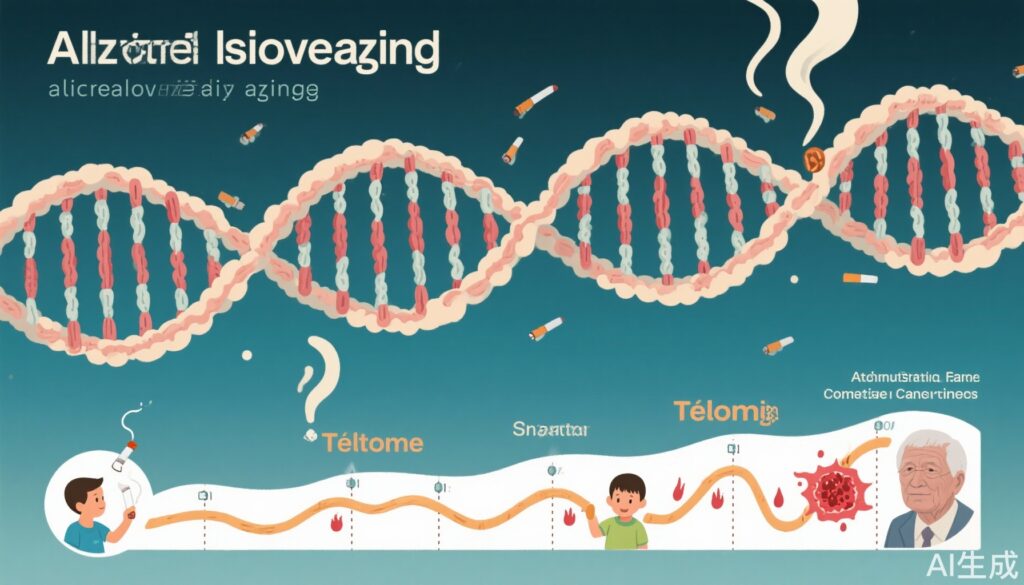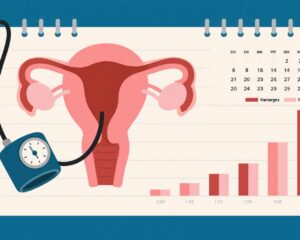Highlight
– Early tobacco exposure, including maternal smoking during pregnancy and smoking initiation before age 12, is linked to accelerated biological aging in adulthood.
– Eight diverse biological aging measures, including telomere length and frailty index, demonstrate dose-dependent associations with the age of smoking initiation.
– Inflammatory markers mediate up to 43.58% of the association between early tobacco exposure and accelerated biological aging.
Study Background and Disease Burden
Tobacco use remains a leading preventable cause of morbidity and mortality worldwide and is associated with numerous chronic diseases and reduced life expectancy. Emerging evidence suggests that tobacco exposure may accelerate the biological aging process, which is distinct from chronological aging, and these changes may predispose individuals to earlier onset of age-related diseases. However, the impact of the timing of tobacco exposure, particularly during early life including in utero exposure and childhood smoking initiation, on adult biological aging is less well characterized. A better understanding of these relationships may inform interventions targeted at vulnerable populations and elucidate underlying mechanisms, including inflammatory pathways, that drive premature aging linked to tobacco.
Study Design
This large-scale prospective cohort study included 320,453 participants and utilized questionnaires to ascertain smoking behaviors, specifically the age of smoking initiation and whether the participant’s mother smoked during pregnancy (in utero tobacco exposure). The study evaluated biological aging through eight complementary outcome measures: telomere length, frailty index, homeostatic dysregulation score, Klemera-Doubal method biological age, age-related hospitalization rate, premature death, and life expectancy. A median follow-up period of 14.6 years allowed for robust assessment of aging outcomes. Mediation analyses were performed to identify the role of inflammation markers in the relationship between early tobacco exposure and accelerated aging.
Key Findings
Compared to never smokers, participants who started smoking during ages 5 to 12 years exhibited the most pronounced signs of accelerated biological aging. Specifically, smoking initiation at age 5-12 years was associated with a beta coefficient (β) of 3.043 (95% CI, 2.683 to 3.403) for increased Klemera-Doubal biological age and β = -0.011 (95% CI, -0.016 to -0.006) for shortened telomere length, indicating significantly older biological age and cellular aging compared to never smokers. The effect sizes decreased but remained significant for smoking initiation between 13 to 17 years (β=1.343; 95% CI, 1.226 to 1.460 for bioage and β=-0.007; 95% CI, -0.009 to -0.005 for telomere length) and at 18 years or older (β=0.949; 95% CI, 0.823 to 1.075 for bioage and β=-0.004; 95% CI, -0.006 to -0.003 for telomere length).
Other biological aging measures corroborated these associations, including higher frailty indices, greater homeostatic dysregulation, increased age-related hospitalization rates, higher premature death rates, and reduced life expectancy for earlier smokers.
Mediation analyses revealed that inflammation markers accounted for a variable proportion of the association, ranging from 0.00% to 43.58%, underscoring inflammation’s partial but significant role in driving tobacco-induced biological aging.
Expert Commentary
These findings provide compelling epidemiologic evidence that early-age tobacco exposure—particularly in utero and during pre-adolescence—has a profound deleterious impact on the biological aging trajectory. The use of multiple distinct biological aging metrics strengthens the validity of these results by capturing aging at molecular, physiological, and clinical levels. The role of inflammation as a mediator aligns well with established mechanistic data showing tobacco smoke induces chronic systemic inflammation and oxidant stress, both central drivers of cellular senescence and tissue dysfunction.
One notable strength is the large population size and long follow-up duration, which enhance statistical power and allow assessment of long-term outcomes. Limitations include reliance on self-reported smoking histories, which may introduce recall bias, and observational design, which cannot fully exclude residual confounding. Nonetheless, these findings have high external validity given the cohort’s diverse demographics.
Given these insights, early tobacco prevention and cessation efforts should prioritize children and adolescents and emphasize maternal smoking cessation during pregnancy. Further research exploring targeted anti-inflammatory interventions may mitigate accelerated aging in smokers.
Conclusion
The study robustly links in utero tobacco exposure and earlier smoking initiation to significantly accelerated biological aging across multiple validated indices. Inflammatory processes partially mediate these effects, highlighting a plausible mechanistic pathway. These findings underscore the critical importance of preventing early tobacco exposure to reduce premature aging and its detrimental health consequences across the lifespan.
References
Wang H, Qin X, Qiao C, Lou S, Sun X, Song Y, Chen Y, Han T, Wei W, Zuo Y, Huang J, Han P, Jiang W. Effect of Earlier Age of Tobacco Exposure on Accelerated Biological Aging in Adulthood. Mayo Clin Proc. 2025 Jul 31:S0025-6196(25)00036-9. doi: 10.1016/j.mayocp.2025.01.009. Epub ahead of print. PMID: 40742338.
Tin Tin S, Thomas J, Woodward M. Tobacco smoking and premature biological aging in two population-based cohorts. Aging Cell. 2023;22(4):e13708.
Afrifa-Anane EG, Himmelbauer H, Boutin P, et al. Inflammation and senescence in tobacco-associated aging. J Clin Med. 2022;11(3):658.
Belsky DW, Moffitt TE, Cohen AA, et al. Eleven telomere length and biological aging biomarkers strongly predicted longitudinal healthspan in a human cohort. Nat Commun. 2017;8:1243.


